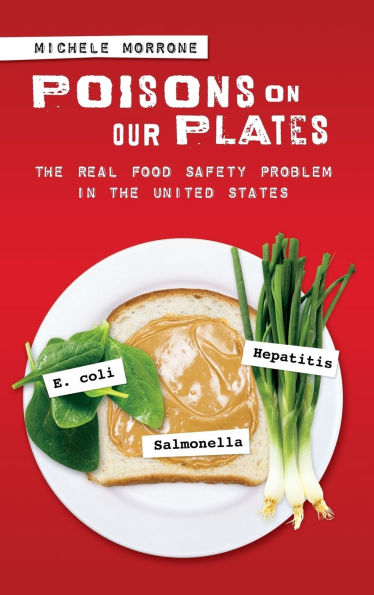Poisons on Our Plates: The Real Food Safety Problem in the United States
The safety of our food supply is an environmental health issue that affects every American citizen. The Centers for Disease Control and Prevention estimate that more than 76 million people in the United States suffer from foodborne illnesses every year. Microbiological contamination—bacteria, viruses, and parasites—is the leading cause of foodborne illness. Morrone faults the media for focusing the anxieties of the American public on such issues as irradiated food, genetically modified foods, and mad cow disease, while ignoring the microbial foodborne pathogens that are running amok in our food supply—except when point-source outbreaks of E. coli in spinach and green onions or salmonella in peanut butter sicken thousands of people at once.
Many readers will be alarmed to learn from Poisons on Our Plates that there is no federal environmental health policy or agency that controls the bacteria and viruses in our food supply. The FDA Food Code and various voluntary systems overseen by local health departments are woefully inadequate. Drawing on disturbing stories told by food safety professionals as well as on statistical studies, the author paints a grimly fascinating picture of the impact of bacteria and viruses on our food supply and how they can make us sick. Morrone examines the increased risks that come with the rise in food imports from high-contamination countries such as China and Mexico. She advocates major changes to our nation's environmental health policies in order to control the growing dangers that foodborne illness pose to public health.
1111522376
Many readers will be alarmed to learn from Poisons on Our Plates that there is no federal environmental health policy or agency that controls the bacteria and viruses in our food supply. The FDA Food Code and various voluntary systems overseen by local health departments are woefully inadequate. Drawing on disturbing stories told by food safety professionals as well as on statistical studies, the author paints a grimly fascinating picture of the impact of bacteria and viruses on our food supply and how they can make us sick. Morrone examines the increased risks that come with the rise in food imports from high-contamination countries such as China and Mexico. She advocates major changes to our nation's environmental health policies in order to control the growing dangers that foodborne illness pose to public health.
Poisons on Our Plates: The Real Food Safety Problem in the United States
The safety of our food supply is an environmental health issue that affects every American citizen. The Centers for Disease Control and Prevention estimate that more than 76 million people in the United States suffer from foodborne illnesses every year. Microbiological contamination—bacteria, viruses, and parasites—is the leading cause of foodborne illness. Morrone faults the media for focusing the anxieties of the American public on such issues as irradiated food, genetically modified foods, and mad cow disease, while ignoring the microbial foodborne pathogens that are running amok in our food supply—except when point-source outbreaks of E. coli in spinach and green onions or salmonella in peanut butter sicken thousands of people at once.
Many readers will be alarmed to learn from Poisons on Our Plates that there is no federal environmental health policy or agency that controls the bacteria and viruses in our food supply. The FDA Food Code and various voluntary systems overseen by local health departments are woefully inadequate. Drawing on disturbing stories told by food safety professionals as well as on statistical studies, the author paints a grimly fascinating picture of the impact of bacteria and viruses on our food supply and how they can make us sick. Morrone examines the increased risks that come with the rise in food imports from high-contamination countries such as China and Mexico. She advocates major changes to our nation's environmental health policies in order to control the growing dangers that foodborne illness pose to public health.
Many readers will be alarmed to learn from Poisons on Our Plates that there is no federal environmental health policy or agency that controls the bacteria and viruses in our food supply. The FDA Food Code and various voluntary systems overseen by local health departments are woefully inadequate. Drawing on disturbing stories told by food safety professionals as well as on statistical studies, the author paints a grimly fascinating picture of the impact of bacteria and viruses on our food supply and how they can make us sick. Morrone examines the increased risks that come with the rise in food imports from high-contamination countries such as China and Mexico. She advocates major changes to our nation's environmental health policies in order to control the growing dangers that foodborne illness pose to public health.
75.0
Out Of Stock
5
1

Poisons on Our Plates: The Real Food Safety Problem in the United States
192
Poisons on Our Plates: The Real Food Safety Problem in the United States
192
75.0
Out Of Stock

Product Details
| ISBN-13: | 9780313349751 |
|---|---|
| Publisher: | Bloomsbury Academic |
| Publication date: | 06/30/2008 |
| Series: | Politics and the Environment |
| Pages: | 192 |
| Product dimensions: | 6.30(w) x 9.30(h) x 1.00(d) |
About the Author
From the B&N Reads Blog



